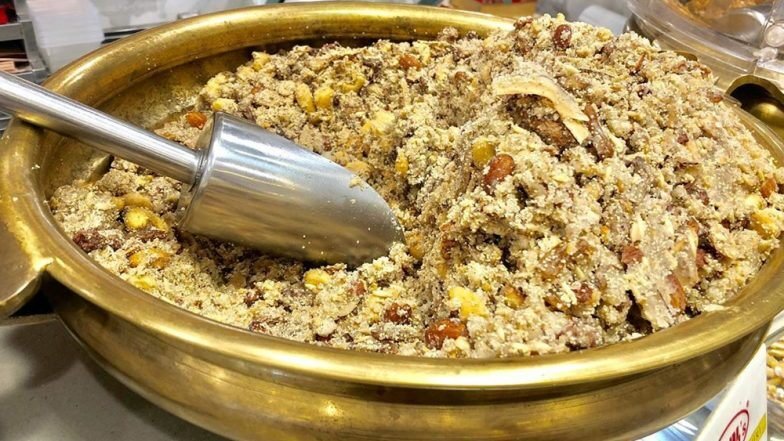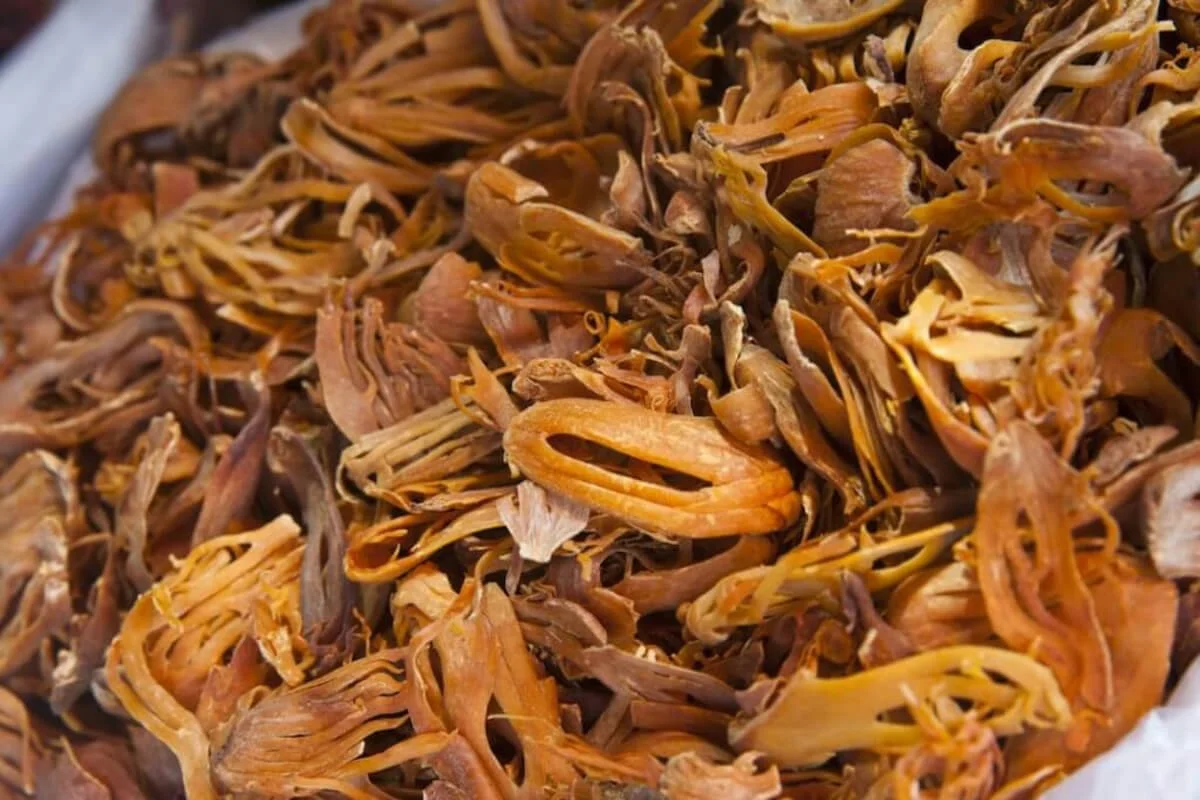Healthy Panjeeri Mix – My Great Grandmother’s Recipe
Discover > Texas Mom Blog > Healthy Panjeeri Mix – My Great Grandmother’s Recipe
In every family, there are always those recipes that come down for generations. Delicately preserved notes, losing their ink with the passage of time, food stains here and there, proving someone’s efforts as they tried to follow the instructions and cook at the same time. It is upon us, the ones who come later, to guard the words left behind by our elders. One such recipe that has been in my family for more than three generations is a granola (how long does granola last?) like healthy nut and seed mix called Panjeeri. It is especially made for pregnant and post-partum women, to aid with healing and breastfeeding. This mix is traditional to the Indian subcontinent, but with migration, the dish has travel far and wide. While there are many styles of preparing it, some basic ingredients remain the same and ideally, should not be substituted.
How is Panjeeri Prepared
Panjeeri is made from roasting seeds, nuts, dried fruit (how long does dried fruit last?), flour (how long does flour last?) and herbal spices, that are used in traditional medicine. The main ingredients of this mix are fox nuts (What wine goes well with nuts?) and acacia gum. Yes, you heard that right. Acacia gum is the edible gum that seeps out of gum producing trees of the Middle East and the Indian subcontinent. Edible gum has been used for centuries in herbal, traditional medicine and it only goes on to show how people in olden times treated ailments through nature and not chemicals.
The roasting is done in pure ghee (how long does ghee last?) or clarified butter, and this part is important, as ghee is lactose free and much healthier than conventional oil or even butter. It also helps in better digestion of the Panjeeri.
Once roasted, the ingredients are allowed to cool down and ground to a find powder. Raw brown sugar (how long does sugar last?), jaggery (how long does jaggery last?) or sugar can be added as a sweetener.
How To Eat Panjeeri
Anyone can enjoy panjeeri at any time of the year, but it is particularly made during the winter months. It is known for its healing and restorative properties, so it is ideal for people who are battling illness, pregnant women, and nursing mothers.
Usually, panjeeri is usually eaten in its powdered form and is meant to be had in small quantities. 3 tablespoons in a day should suffice, but God knows I've eaten a lot more when I was post-partum with my three kids!
The way I have incorporated panjeeri into our household without any pregnant or sick people, is to add it to my breakfast routine. A spoon of panjeeri added to a mug of hot milk or a milk substitute and you are good to go! For the kids, warm panjeeri milk gives them better nutrition than a having a bowl of store-bought cereal! Adding it to a drink also saves your teeth from a lot of residue being stuck early in the morning!
While there are healthier ways of preparing it, for example, dry roasting the ingredients instead of frying them in ghee. But for all the benefits that ghee has, do make it the traditional way. After all, panjeeri is meant to be consumed very lightly. One tablespoon a day at breakfast time doesn’t add too many calories to your overall daily intake.
Best Way to Store Panjeeri
It is best to store it in a glass container with an airtight lid. You can keep it on the countertop for easy access, and it usually stays fresh for a couple months. But its always ideal to have it within a month. If you make more than what you need, refrigerate the extra in a food container or a Ziploc bag so it stays fresh.
Benefits of Panjeeri
Therapeutic panjeeri made for fighting a certain sickness needs to be custom made keeping in mind the person. Panjeeri, otherwise is also quite nutritious and health restoring.
Whole wheat flour (how long does whole wheat flour last?) or other alternatives like Millet (how long does millet last?) flour or buckwheat flour (how long does buckwheat flour last?) provide fiber, potassium, B vitamins and vitamin E.
Coconut contains salicylic and gallic acid which are powerful antioxidants that protects our cells from oxidative damage.
Almonds (how long do almonds last?), walnuts (how long do walnuts last?), fox nuts, desiccated coconut, pine nuts and cashew nuts all contain medium chain fatty acids, Omega 3’s, calcium, and protein. Fox nuts are especially known for containing kaempferol, a flavonoid that has anti-ageing and anti-inflammatory properties.
Melon seeds (how long do seeds last?), cardamom pods (how long do cardamom pods last?) & seeds, and fennel seeds (how long do fennel seeds last?) have antispasmodic and anti-septic properties that promote lymphatic flow.
Acacia gum aids in wound healing, reduces cholesterol levels, reduces risk of hemorrhaging during delivery, and promotes sound cardiovascular health.
Turmeric powder, Ginger powder (how long does ginger powder last?), Mace, (how long does mace last?) & Nutmeg (how long does nutmeg last?) have anti-inflammatory, antifungal and antibacterial properties. These spices eliminate toxins from the liver, promote blood circulation, and help clear mucus and arterial plaque.
Simple and Effective Panjeeri Recipe
So, this recipe requires a good amount of prep. You need to measure out the ingredients, soak and dry roast them.
Before you begin, read the tips at the bottom of this blog to make the process easier.
What You Will Need
Whole wheat flour or any other alternative flour, 1 cup
Desiccated coconut, 1 cup
Brown sugar, 1 cup
Fox nuts, 1 cup, also called lotus seed
Acacia gum, ¼ cup
Jaggery, roughly crushed, 150 grams
Green raisins (how long do raisins last?), ½ cup
Almonds, ½ cup
Cashew nuts, ½ cup
Pine nuts, ¼ cup
Walnuts, ½ cup
Melon seeds, 1/2 cup
Fennel (how long does fennel last?) seeds, 1 tablespoon
Cardamom pods, 6-8 whole
Turmeric powder, ½ teaspoon
Ginger powder, ½ teaspoon
Nutmeg powder (how long does nutmeg powder last?), 1/2 teaspoon
Mace, 1 blade, ground.
Ghee or organic coconut oil, 1 cup
What You Will Have to Do
Soak beforehand the almonds, melon seeds, cashew nuts, pine nuts and walnuts. Once soaked for at least 2 hours, peel the skin off the almonds.
Dry roast the soaked ingredients on a low flame till they are dry with a slight toasty color. Set aside.
Very lightly dry roast cardamom pods and mace blade and set aside to cool.
Dry roast the desiccated coconut and set aside to cool.
In a heavy bottomed wok, heat 4 tablespoons of ghee and roast the edible gum. Once it puffs up, stops crackling and turns an opaque color, take it off the heat and let it cool down.
Again, take 4 tablespoons of ghee. Roast the fox nuts and once they puff up and turn a golden color, take them off the heat and set aside to cool.
Add the remaining ghee and roast the whole wheat flour till it turns a beautiful gold color. Remove from the wok and let it cool.
Once all the ingredients are cooled, grind them to a fine powder in a coffee grinder. Bring them together in a large container and mix well.
Add the jaggery, raisins and brown sugar.
Add the ginger powder, turmeric powder and nutmeg powder and mix well.
Helpful Tips:
When using ghee to roast the flour, add lesser than what you have left. It shouldn’t turn the flour into a batter like consistency but be enough to bring it together into small buttery lumps.
If you really like to bring the fat content of this recipe down, substitute the ghee with organic coconut oil, or even skip the oil. Dry roasting the ingredients on a low flame works well too.
Remember to take your time with the roasting, so the components don’t turn brown. Over roasted ingredients will turn the panjeeri bitter.
Add the brown sugar gradually, tasting as you go.
Patience is key to the best panjeeri. Do not rush and you will love the flavors.
Want to enjoy your favorite fresh herbs year-round? How about growing your own winter herb garden? Read here to learn how!





